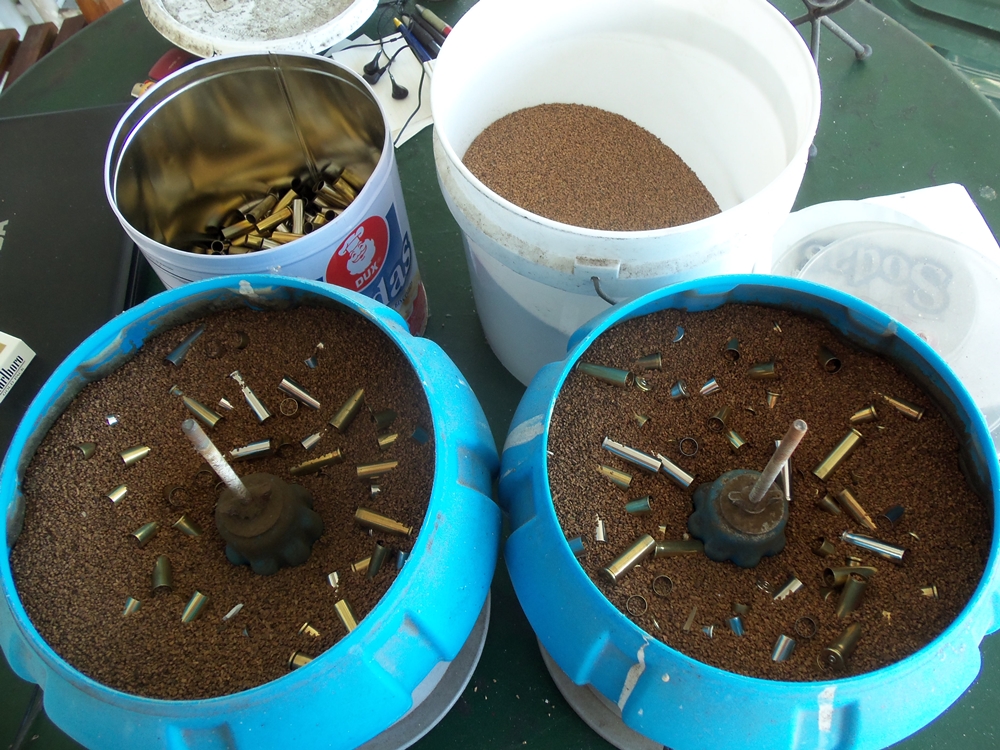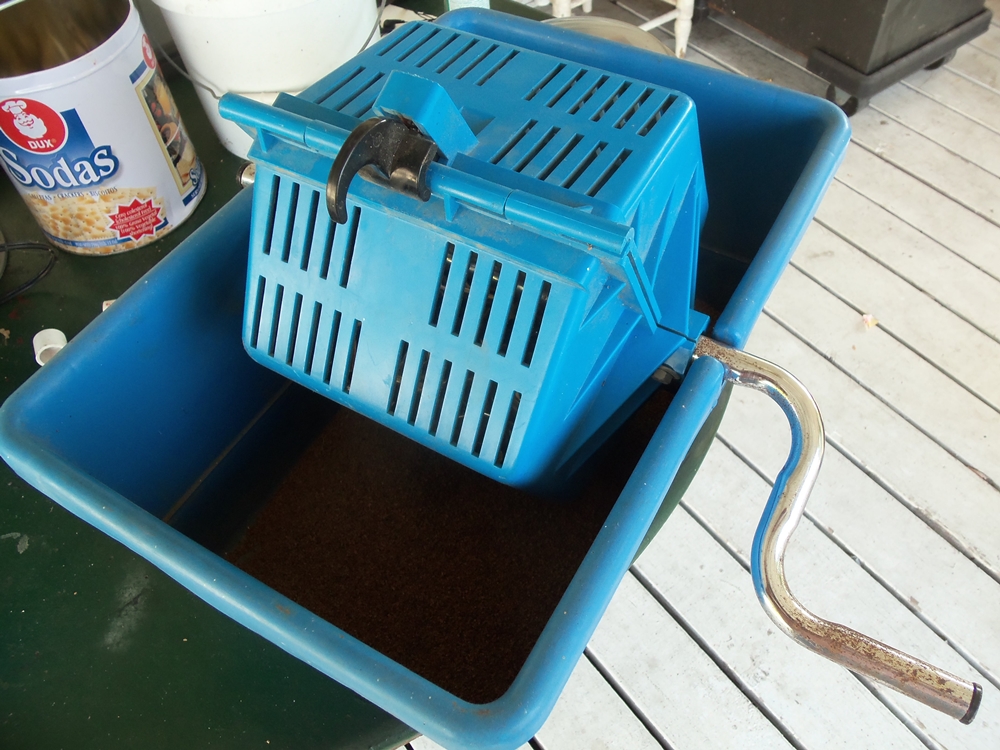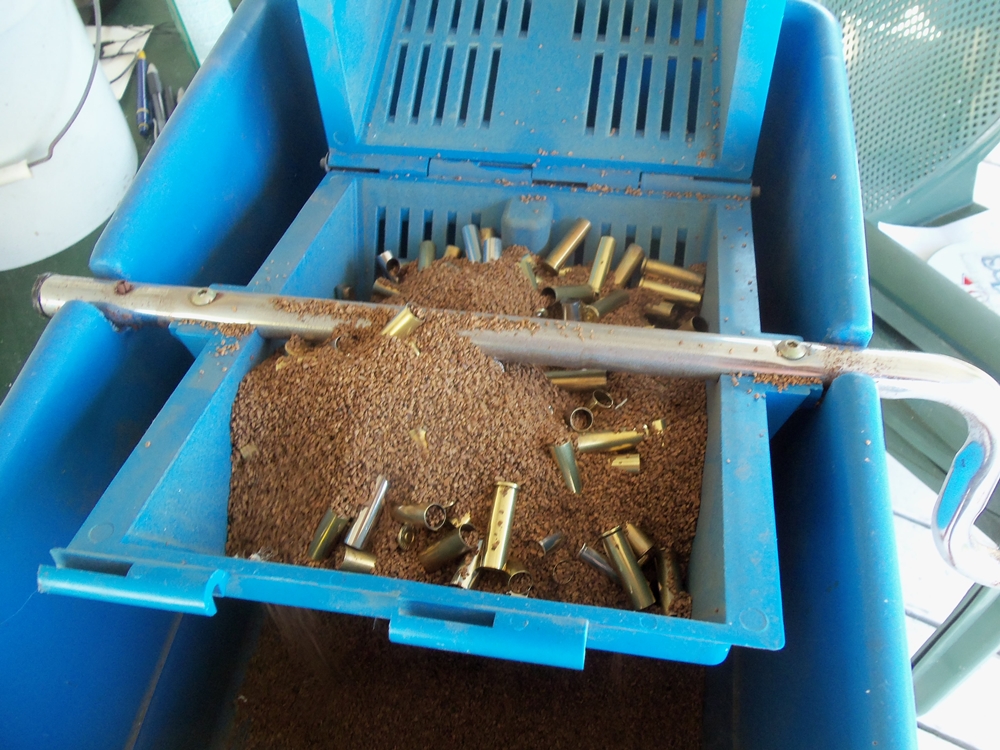Since I found myself out of .357 magnum to shoot Saturday’s match, I had to rush and get me some. I reload so I am gonna take this opportunity to share a bit of what I do and encourage others to do it.
Reloading & Handloading is easy. You will obviously need equipment, but if you are starting and don’t mind the extra work, used equipment is available. Some equipment is so cheap you really do not need to go the used way.
Let’s start with case preparation. Unless you are buying your brass fresh from the factory, you are going to be using collected brass from the range. This brass will be dirty and will need a nice cleaning before going to the press. You really do not want dirt in your gun or reloading dies.
 The two blue bowls bellow are tumblers. I got them used from a shooting buddy for a pittance and have served me well over the years. A tumbler is basically a covered bowl attached to a motor which makes it vibrate. Inside the bowl you have cleaning media (in this case crushed walnut shells I got from a pet store and that are way cheaper than the media you can buy at specialty stores) add your dirt brass, cover the bowl and start cleaning. I add a teaspoon of Brasso which helps accelerate the cleaning/polishing process. Depending on the level of filthiness, time of cleaning can go from as short as 90 minutes to four hours.
The two blue bowls bellow are tumblers. I got them used from a shooting buddy for a pittance and have served me well over the years. A tumbler is basically a covered bowl attached to a motor which makes it vibrate. Inside the bowl you have cleaning media (in this case crushed walnut shells I got from a pet store and that are way cheaper than the media you can buy at specialty stores) add your dirt brass, cover the bowl and start cleaning. I add a teaspoon of Brasso which helps accelerate the cleaning/polishing process. Depending on the level of filthiness, time of cleaning can go from as short as 90 minutes to four hours.
 After the 90 minutes, the cases are clean and looking purty & shinny!. Now comes the separation.
After the 90 minutes, the cases are clean and looking purty & shinny!. Now comes the separation.
Separation, as the name suggest deals with isolating the media from the cases. If you are really really tightfisted, you can use a pasta colander as media separator but it will require a good hand-eye coordination or you will have brass, crushed walnuts shells and a very pissed off significant other. Splurge some and by a proper case separator, they are not that expensive.
 Yes! It does look like one of those bingo things and works on the same principle: You turn the lever, the whole thing goes round and round.
Yes! It does look like one of those bingo things and works on the same principle: You turn the lever, the whole thing goes round and round.
 As you turn the handle, the media will leave through the slits leaving you with a nice batch of clean brass for your reloading needs. Just place your brass in a container and the cleaning part of the case preparation is over.
As you turn the handle, the media will leave through the slits leaving you with a nice batch of clean brass for your reloading needs. Just place your brass in a container and the cleaning part of the case preparation is over.
Note: Some people like to Resize & Decap first and then clean. I have done it that way and later find myself having to remove media from the primer pocket which annoys me to no end. To each its own.
More to come.

tip: do not use Brasso as it contains ammonia which will cause one’s brass to become brittle. brittle brass cracks sooner, shortening the life of the cases and perhaps causing Bad Things to happen, like case head separations. better to use commercial brass polish (i use Dillon’s) that conains no ammonia.
oh, i also like that you’re using Dillon equipment. good stuff. 🙂
I keep hearing that about ammonia, but in 5 years I have not detected the lightest problem. And the occasional teaspoon is not gonna hurt that much.
The tumblers are Midways…..Old Midways.
I don’t do Dillons.
Forget about the tumbling. I’ve had the privilege of shooting with some of the world’s best long-range shooters (not that I’m good, just squadded with them). They say DO NOT use abrasive tumbling, as it does get into the barrel and does shorten barrel life. True, this is for long-range rifles, quite different than the .357 revolver. But the solution is easy and applies to both:
Use the ultrasonic cleaners. I’ve used them extensively in the lab and at the loading bench. They do a much better job of cleaning than the tumblers do. Sometimes they get all of the grime out of the primer pocket, but even if they don’t, what remains comes out easily with a pocket cleaner.
After cleaning rinse in water, shake a bit to remove most of the water, then put in an oven set at 230 F for 10 – 15 min. Too long and you might get what looks like purple anodizing (actually helps pick out my brass on the range). Theoretically, there might be a risk of embrittlement if heated too long, but I’ve had no problem through many reloading cycles.
There might be some trouble with the significant other, but even my primadonna b$$$h ex would let me do it in “her” oven, as I showed her it left no odor or other problem behind.
You can find recipes online for your cleaner solution. I just use the detergent that comes with the sonicator. And no, I am not receiving any remuneration for this post.
I understand that ultrasonic cleaners are the greatest way, but for the price of one of the really cheap ones, you can buy a regular tumbler and a media/case separator with enough money left for a lifetime supply of cleaning media.
Do note that I view reloading from the point of view of a competition shooter that deals in volume but has no deep pockets. Your points are right on the money as applied to the “weird” world of benchrest & long distance shooting which amazes me to no end. I cannot fathom people hitting with precision targets set so far away I cannot see with the naked eye. They have my total respect and I bow in admiration.
[…] I see Miguel at Gun Free Zone has a nice pictorial post on case cleaning, the first step in the reloading cycle. Those who are considering ‘rolling your own’ could do a lot worse than clicking here and… […]
I know you’re dealing with only .357 Mag brass, but as soon as you mentioned range brass, the first thing that came to mind was to sort the brass by caliber before tumbling. PITA pulling 9mm out of .40 S&W out of .45ACP, and no fun at all to run a .357 Mag casing into a .38 Special die.
I reload too many calibers for my own good. Keeping them separated makes for fewer headaches.
Tim
Good point. Sorting is annoying to say the least. People do speak well of this brass sorter